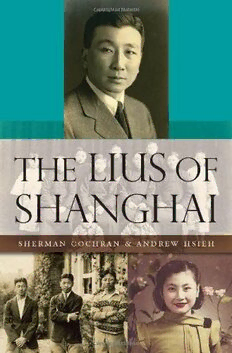
The Lius of Shanghai PDF
Preview The Lius of Shanghai
lius the of shanghai sherman cochran & andrew hsieh THE LIUS OF SHANGHAI THE LIUS OF SHANGHAI q SHERMAN COCHRAN ANDREW HSIEH HARVARD UNIVERSITY PRESS Cambridge, Massachusetts London, En gland 2013 Copyright © 2013 by the President and Fellows of Harvard College All rights reserved Printed in the United States of America Library of Congress Cataloging- in- Publication Data Cochran, Sherman, 1940– The Lius of Shanghai / Sherman Cochran and Andrew Hsieh. p. cm. Includes bibliographical references and index. ISBN 978- 0-6 74-0 7259-6 (alk. paper) 1. Family- owned business enterprises—C hina—History—20th century. 2. Liu family. I. Xie, Zhengguang. II. Title. HD62.25.C63 2013 338.092'251132—dc23 2012039399 For Macu and Ming q Contents Preface ix Introduction: Family Dynamics under Patriarchy 1 I PLANNING A BUSINESS DYNASTY, 1907– 1932 1 Parents Who Dreamed of a Business Dynasty 13 2 Sons Who Tried for Admission to Cambridge 23 3 Sons Who Did Not Want to Become British Citizens 49 II BEHAVING CONTRARY TO THE PLAN, 1932– 1937 4 A Son Who Wanted to Drop Out of Harvard 67 5 A Son Who Was Sick 90 6 A Son Who Proposed Marriage to a Westernized Woman 116 7 A Daughter Who Spoiled a Marriage Alliance 147 III REACTING TO WAR, 1938– 1945 8 Sons Who Became Leaders in Wart ime 165 9 A Son Who Joined the Communists 185 10 A Son Who Battled Depression 217 11 Mother’s Struggle to Save Her Marriage 237 12 The Family’s Postwar Disunion and Reunion 259 viii Contents IV ADAPTING TO REVOLUTION, 1946– 1956 13 Father’s Decision to Live in the People’s Republic 279 14 A Daughter Who Forged Family Alliances 298 15 A Son Who Refused to Return to China 325 16 Parents’ Deaths and Children’s Dispersal 344 Conclusion: The Inner History of a Chinese Family 355 Archives and Works Cited 367 Notes 377 Ac know ledg ments 421 Index 425 q Preface On a cold winter day in 1992, I saw letters in the Liu family’s corre- spondence for the fi rst time. I was seated in a solid, wooden, straight- backed chair at the Center for Research on Chinese Business History in the Shanghai Academy of Social Sciences (SASS) when Professor Huang Hanmin, the director of the Center, delivered the letters to my desk. By the standards of American archives and libraries, it was not a comfort- able place. According to China’s policies at the time, public buildings south of the Yangzi River were not heated in winter, and since Shang- hai is located on the Yangzi River, it was one of the northernmost cities wholly lacking in this amenity. But if my personal discomfort initially distracted me, I became completely focused as soon as I opened the fi rst box of the Liu family letters and began to read. Instantly I felt transported into the world of the Liu family. Four hours later I was startled when Professor Huang pointed out that it was time for lunch. I had sat through the morning without moving a mus- cle except to turn the pages of the old and fragile onionskin paper on which the letters w ere written. At that moment I resolved to write a book about the Liu family that would somehow allow readers to share with me what I had experienced on that bitterly cold and utterly ex- hilarating day. Why was I immediately drawn into these letters? Admittedly, I had preexisting reasons for taking an interest in the Center’s holdings in general and its materials on the Lius in part icu l ar. I had been visiting SASS regularly for nearly a dec ade (since 1983), and in the early 1990s I had teamed up with two of SASS’s most distinguished Chinese scholars,
